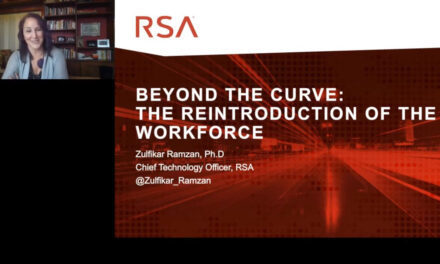Financial data is most susceptible to cyber-threats in the wake of COVID-19, and organizations are playing catch-up to ensure security and compliance.
Remote working has caught many business functions on the wrong foot during the COVID-19 pandemic.
For instance, many finance teams have had to adopt new ways of working to ensure they continue to close their books and conduct audits in a distributed workforce, rather than rely on manual processes.

This has cast a spotlight on digitizing processes such as cloud-based solutions or automating payrolls for companies that had not done so previously to ensure compliance and convenience.
However, the pace at which cybersecurity solutions are deployed is not necessarily as fast as digital adoption. In fact, the financial sector is the most susceptible to cyber-threats due to sensitive data. Financial services firms are 300 times as likely as other companies to be targeted by a cyberattack.
What can IT and Finance & Accounting (F&A) teams do to build strong security systems to ensure data protection and a more robust F&A process?
Terry Smagh, Senior Vice President & General Manager, Asia Pacific & Japan at BlackLine, shared some insights with CybersecAsia:
What do you foresee for 2021 and beyond for the finance and accounting professions, especially where cybersecurity, data management and AI are concerned?
Smagh: Future F&A professionals will need to be quicker in accelerating adoption of modern technologies such as automation, artificial intelligence and machine learning. These technologies will become more commonplace within the next five years.
Notably, almost 80% of accounting tasks, such as audit and statutory and regulatory reporting, are expected to be carried out by machines. Businesses are placing a renewed focus on risk management, control environments, and cash flow optimization, and are leveraging automation and AI to address these areas.
While such technologies play important roles, humans are the ones who ultimately put them to work. F&A professionals should not only be familiar with how they operate, but also define rules and input for the machines to produce more accurate and relevant output.
Being accustomed with these technologies will also allow them to pass off time-consuming and labor-intensive tasks. Future professionals will take on strategic higher-level analytical tasks and advance to become invaluable sources of counsel. This will require them to be well-equipped with data analytical skills, as they have to transform financial data produced by machines to extract concise and decision-driving insights that drive business forecasts.
The modern finance function therefore requires a combination of emerging technologies and dynamic human talent. It is now a strategic partner that is less inward-looking and more forward-looking, offering better forecasting, and business insight.
2020 has also underscored the importance of safe cyber practices, especially as different sectors witness an increase in cyber-attacks during the pandemic. This is worrying for the finance sector, as it is the most susceptible to cyber-threats due to sensitive data. In fact, financial services firms are 300 times as likely as other companies to be targeted by cyber criminals.
Cybersecurity will no longer just be the responsibility of IT professionals. F&A professionals should also take active steps to ensure confidential data is kept secure. They should adopt practices such as password protection and authentication, regular data back-ups, as well as be knowledgeable about possible cyber risks their organization might face. This allows them to better protect themselves from potential massive breaches and ransomware attacks.
Data will continue to be critical in making financial decisions for businesses. More organizations are realizing the power of data in fueling transformation in the F&A sector, enabling real-time knowledge of financial matters and uncovering new insights which were not possible previously. Given that the pandemic has also sped up the growth of big data, more F&A teams will leverage insights from data to enhance their internal processes and in turn generate more revenue.
How can F&A teams work with IT and other departments to improve data management and cybersecurity practices?
Smagh: Companies today might still encounter a convoluted database of unmatched transactions and manual reporting processes. F&A teams should work together with other departments such as IT to spearhead a shift towards new solutions that can foster collaboration and improve access to data.
These can range from automated platforms that reduce time spent on retrieving financial information to others that consolidate data into one centralized location. Such new technologies should also be delivered over the cloud ideally, are accessible anywhere and on multiple platforms for seamless collaboration among different teams.
Business leaders should consider moving away from legacy systems and leverage new technologies instead to minimize cyber-fraud risk. AI and machine learning help match high-volume transactions across areas like bank to accounts receivable, and credit card. This allows teams to screen for problems and identify anomalies that can be quickly acted upon.
For example, BlackLine Cash Application is one solution that leverages AI and machine learning to enable organizations to manage cash flow and cash collection in real time, simplifying the order-to-cash process. Centralized dashboards can depict trends and exceptions on accounts and transactions, enabling F&A professionals to focus on hunting down issues before they spiral out of control.
Collaboration among business leaders is essential to introduce upskilling and retraining programs amongst teams. F&A teams can look to work alongside business development teams, and acquire a thorough understanding of the business which helps them better understand and sift through hefty financial data. IT teams can provide best practices around data protection, ensuring F&A professionals can effectively tackle a new cybersecurity era.
Enhancing cybersecurity practices and data management is a company-wide initiative and will require employees to be comfortable with job re-design and working with colleagues across a wide range of functions. This helps to accelerate learning across organizations, and enables teams to better respond to increasing unpredictability.
What best practices should IT equip finance with to better transition to digitalized solutions?
Smagh: IT teams should look to partner with technology vendors and implement solutions which eliminate manual processes and centralize massive volumes of data. One example is BlackLine’s Intercompany Hub (ICH).
ICH provides a single-pane of glass view over all financial transactions and operations. This takes the hassle out of manually identifying transactions from thousands of spreadsheets. It also reduces the risk of human error as the system automates transfers as they happen, providing full visibility to transactional data and various workflows.
BlackLine Account Analysis is another new solution that also helps mitigate risk in high-volume accounts, by automatically analyzing transactions in complex, high-volume accounts. Such benefits allow finance teams to move away from traditional practices with confidence, and better adapt to digitalized solutions.
Moreover, IT and finance teams should work together to cultivate a culture of collaboration. CIOs and CFOs are partners in driving the digital transformation journeys of businesses. Being able to work closely offers a more comprehensive overview of operations and a better alignment between IT investments and strategic growth plans that optimize business performance.
A close partnership between IT and finance can also improve the use of data. For instance, CIOs can help determine businesses invest in solutions which can provide insights that finance requires. Meanwhile, CFOs will help ensure data from new solutions is made more accessible to authorized personnel, so they can drive more business insights.
What must teams understand about the safe use of digitalized solutions?
Smagh: Remote working within the Asia Pacific region is here to stay and having a dispersed workforce can bring about various data management challenges.
Cloud technology is fast becoming the backbone of all remote workers during the global pandemic, including the finance technology landscape. This gives rise to greater cybersecurity risks and underscores the critical role personal cyber-hygiene practices plays in the current remote working landscape.
Teams need to understand that they need to adhere to strict cybersecurity rules and practise cyber-hygiene to reap the benefits of digitalized solutions safely.
Recent findings from a 2020 Data Threat Report – Asia Pacific (APAC) by Thales revealed that of the 45% of all of APAC’s corporate data stored in the cloud, only 52% of these sensitive information are protected by encryption.
Furthermore, remote workers often use personal network connections and devices, which does not necessarily have the built-in security which office systems do, and are more vulnerable to cyberattacks. The survey conducted by Thales also revealed that 45% of APAC executives have suffered a breach or failed a compliance audit while working from home.
Teams will need to understand the importance of safe cyber practices and business leaders will have to enforce strict adherence to cybersecurity regulations. Leaders should also emphasize the importance of cybersecurity education and equip teams with the relevant knowledge needed to protect themselves from cyber threats and relevant problem-solving skills should a cyberattack happen.
How can business leaders lower the hurdles to digital adoption?
Smagh: Business leaders need to ensure they have constant communication and support for employees to better adopt digital solutions
Leaders can also reduce uncertainties surrounding digital adoption by frequently communicating with employees.
Employees are the greatest asset to a business. They are the ones closest to the daily processes and can identify areas to transport for maximum benefits. When kept in the loop, they will have a greater understanding of the reasons for digital transformation and will be able to provide their input and feedback throughout the company’s digital transformation journey.
This would alleviate some resistance to change and increase confidence in the results of digital transformation. Furthermore, it inspires trust within the organization and engages employees on a personal level.
In addition, leaders have to be ready to support their people throughout the digital transformation journey. For instance, business leaders can invest in their people by implementing training courses to upskill or reskill employees.
Through offering continuous learning opportunities and upskilling, employees will be kept updated with the latest technology in the industry. This better enables them to accelerate their learning and adapt to these digital adoptions.
Ultimately, digital transformation is more about the people than the technology itself. Business leaders need to understand that digital adoption is about building a brand of trust and integrating a digital approach aligned with the organization’s values and goals. It is about investing in a digital mindset and inspiring learning with your people, through proper communication and providing support.





















